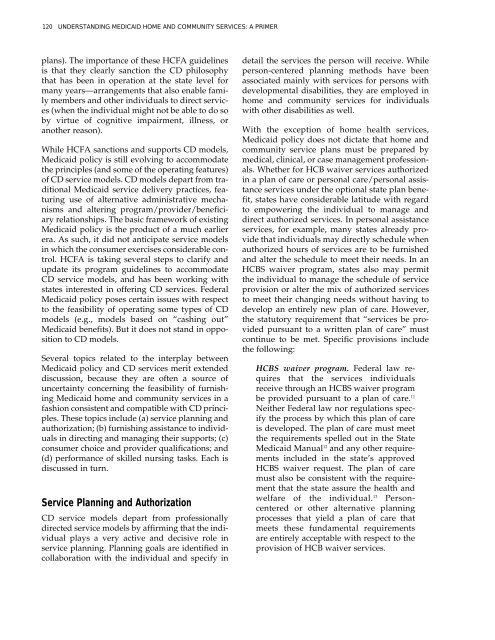Full PDF Version - ASPE - U.S. Department of Health and Human ...
Full PDF Version - ASPE - U.S. Department of Health and Human ...
Full PDF Version - ASPE - U.S. Department of Health and Human ...
- No tags were found...
Create successful ePaper yourself
Turn your PDF publications into a flip-book with our unique Google optimized e-Paper software.
120 UNDERSTANDING MEDICAID HOME AND COMMUNITY SERVICES: A PRIMERplans). The importance <strong>of</strong> these HCFA guidelinesis that they clearly sanction the CD philosophythat has been in operation at the state level formany years—arrangements that also enable familymembers <strong>and</strong> other individuals to direct services(when the individual might not be able to do soby virtue <strong>of</strong> cognitive impairment, illness, oranother reason).While HCFA sanctions <strong>and</strong> supports CD models,Medicaid policy is still evolving to accommodatethe principles (<strong>and</strong> some <strong>of</strong> the operating features)<strong>of</strong> CD service models. CD models depart from traditionalMedicaid service delivery practices, featuringuse <strong>of</strong> alternative administrative mechanisms<strong>and</strong> altering program/provider/beneficiaryrelationships. The basic framework <strong>of</strong> existingMedicaid policy is the product <strong>of</strong> a much earlierera. As such, it did not anticipate service modelsin which the consumer exercises considerable control.HCFA is taking several steps to clarify <strong>and</strong>update its program guidelines to accommodateCD service models, <strong>and</strong> has been working withstates interested in <strong>of</strong>fering CD services. FederalMedicaid policy poses certain issues with respectto the feasibility <strong>of</strong> operating some types <strong>of</strong> CDmodels (e.g., models based on “cashing out”Medicaid benefits). But it does not st<strong>and</strong> in oppositionto CD models.Several topics related to the interplay betweenMedicaid policy <strong>and</strong> CD services merit extendeddiscussion, because they are <strong>of</strong>ten a source <strong>of</strong>uncertainty concerning the feasibility <strong>of</strong> furnishingMedicaid home <strong>and</strong> community services in afashion consistent <strong>and</strong> compatible with CD principles.These topics include (a) service planning <strong>and</strong>authorization; (b) furnishing assistance to individualsin directing <strong>and</strong> managing their supports; (c)consumer choice <strong>and</strong> provider qualifications; <strong>and</strong>(d) performance <strong>of</strong> skilled nursing tasks. Each isdiscussed in turn.Service Planning <strong>and</strong> AuthorizationCD service models depart from pr<strong>of</strong>essionallydirected service models by affirming that the individualplays a very active <strong>and</strong> decisive role inservice planning. Planning goals are identified incollaboration with the individual <strong>and</strong> specify indetail the services the person will receive. Whileperson-centered planning methods have beenassociated mainly with services for persons withdevelopmental disabilities, they are employed inhome <strong>and</strong> community services for individualswith other disabilities as well.With the exception <strong>of</strong> home health services,Medicaid policy does not dictate that home <strong>and</strong>community service plans must be prepared bymedical, clinical, or case management pr<strong>of</strong>essionals.Whether for HCB waiver services authorizedin a plan <strong>of</strong> care or personal care/personal assistanceservices under the optional state plan benefit,states have considerable latitude with regardto empowering the individual to manage <strong>and</strong>direct authorized services. In personal assistanceservices, for example, many states already providethat individuals may directly schedule whenauthorized hours <strong>of</strong> services are to be furnished<strong>and</strong> alter the schedule to meet their needs. In anHCBS waiver program, states also may permitthe individual to manage the schedule <strong>of</strong> serviceprovision or alter the mix <strong>of</strong> authorized servicesto meet their changing needs without having todevelop an entirely new plan <strong>of</strong> care. However,the statutory requirement that “services be providedpursuant to a written plan <strong>of</strong> care” mustcontinue to be met. Specific provisions includethe following:HCBS waiver program. Federal law requiresthat the services individualsreceive through an HCBS waiver programbe provided pursuant to a plan <strong>of</strong> care. 11Neither Federal law nor regulations specifythe process by which this plan <strong>of</strong> careis developed. The plan <strong>of</strong> care must meetthe requirements spelled out in the StateMedicaid Manual 12 <strong>and</strong> any other requirementsincluded in the state’s approvedHCBS waiver request. The plan <strong>of</strong> caremust also be consistent with the requirementthat the state assure the health <strong>and</strong>welfare <strong>of</strong> the individual. 13 Personcenteredor other alternative planningprocesses that yield a plan <strong>of</strong> care thatmeets these fundamental requirementsare entirely acceptable with respect to theprovision <strong>of</strong> HCB waiver services.
















